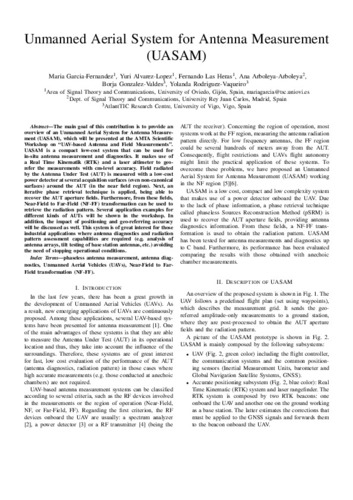Unmanned aerial system for antenna measurement (UASAM)
Palabra(s) clave:
drones
medida de antenas
antenas
UAV
Fecha de publicación:
Editorial:
The IET, EURAAP
Versión del editor:
Descripción física:
Resumen:
The main goal of this contribution is to provide an overview of an Unmanned Aerial System for Antenna Measurement (UASAM), which will be presented at the AMTA Scientific Workshop on “UAV-based Antenna and Field Measurements”. UASAM is a compact low-cost system that can be used for in-situ antenna measurement and diagnostics. It makes use of a Real Time Kinematik (RTK) and a laser altimeter to georefer the measurements with cm-level accuracy. Field radiated by the Antenna Under Test (AUT) is measured with a low-cost power detector at several acquisition surfaces (even non-canonical surfaces) around the AUT (in the near field region). Next, an iterative phase retrieval technique is applied, being able to recover the AUT aperture fields. Furthermore, from these fields, Near-Field to Far-Field (NF-FF) transformation can be used to retrieve the radiation pattern. Several application examples for different kinds of AUTs will be shown in the workshop. In addition, the impact of positioning and geo-referring accuracy will be discussed as well. This system is of great interest for those industrial applications where antenna diagnostics and radiation pattern assessment capabilities are required (e.g. analysis of antenna arrays, tilt testing of base station antennas, etc.) avoiding the need of stopping operational conditions.
The main goal of this contribution is to provide an overview of an Unmanned Aerial System for Antenna Measurement (UASAM), which will be presented at the AMTA Scientific Workshop on “UAV-based Antenna and Field Measurements”. UASAM is a compact low-cost system that can be used for in-situ antenna measurement and diagnostics. It makes use of a Real Time Kinematik (RTK) and a laser altimeter to georefer the measurements with cm-level accuracy. Field radiated by the Antenna Under Test (AUT) is measured with a low-cost power detector at several acquisition surfaces (even non-canonical surfaces) around the AUT (in the near field region). Next, an iterative phase retrieval technique is applied, being able to recover the AUT aperture fields. Furthermore, from these fields, Near-Field to Far-Field (NF-FF) transformation can be used to retrieve the radiation pattern. Several application examples for different kinds of AUTs will be shown in the workshop. In addition, the impact of positioning and geo-referring accuracy will be discussed as well. This system is of great interest for those industrial applications where antenna diagnostics and radiation pattern assessment capabilities are required (e.g. analysis of antenna arrays, tilt testing of base station antennas, etc.) avoiding the need of stopping operational conditions.
Descripción:
European Conference on Antennas and Propagation (EuCAP 2018) (12th. 2018. London)
DOI:
Patrocinado por:
This work has been partially supported by the “Ministerio de Economía y Competitividad” of Spain/FEDER under projects TEC2014-55290-JIN (PORTEMVISION) and TEC2014-54005-P (MIRIIEM); by the “Ministerio of Educación y Cultura” of Spain under FPU grant FPU15/06341; ´ and by the Government of Asturias under project GRUPIN 14-114.
Colecciones
Ficheros en el ítem




